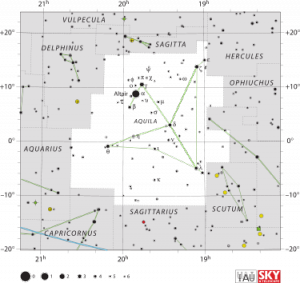Aquila
Aquila is a constellation in the northern sky. Its name is Latin for 'eagle' and it represents the bird who carried Zeus/Jupiter's thunderbolts in Greco-Roman mythology.Aquila lies just a few degrees North of the celestial equator. The alpha star, Altair, is a vertex of the Summer Triangle asterism. The constellation is best seen in the summer as it is located along the Milky Way. Because of this location along the line of our galaxy, many clusters and nebulae are found within its borders, but they are dim and there are few galaxies.
History
Aquila was one of the 48 constellations described by the 2nd century astronomer Ptolemy. It had been earlier mentioned by Eudoxus in the 4th century BC and Aratus in the 3rd century BC. It is now one of the 88 constellations defined by the International Astronomical Union. The constellation was also known as Vultur volans (the flying vulture) to the Romans, not to be confused with Vultur cadens which was their name for Lyra. It is often held to represent the eagle who held Zeus's/Jupiter's thunderbolts in Greco-Roman mythology. Aquila is also associated with the eagle who kidnapped Ganymede, a son of one of the kings of Troy (associated with Aquarius), to Mount Olympus to serve as cup-bearer to the gods. Ptolemy catalogued nineteen stars jointly in this constellation and in the now obsolete constellation of Antinous, which was named in the reign of the emperor Hadrian (AD 117–138), but sometimes erroneously attributed to Tycho Brahe, who catalogued twelve stars in Aquila and seven in Antinous.Hevelius determined twenty-three stars in the first[3] and nineteen in the second.[ The Greek Aquila is probably based on the Babylonian constellation of the Eagle (MUL.A.MUSHEN), which is located in the same area as the Greek constellation.
Mythology
According to Gavin White, the Babylonian Eagle carried the constellation called the Dead Man (LU.USH) in its talons. The author also draws a comparison to the Classical stories of Antinous and Ganymede.[ In classical Greek mythology, Aquila was identified as Αετός Δίας (Aetos Dios), the eagle that carried the thunderbolts of Zeus and was sent by him to carry the shepherd boy Ganymede, whom he desired, to Mount Olympus; the constellation of Aquariusis sometimes identified with Ganymede. In the Chinese love story of Qi Xi, Niu Lang (Altair) and his two children (β and γ Aquilae) are separated forever from their wife and mother Zhi Nu (Vega) who is on the far side of the river, the Milky Way.[ In Hinduism, the constellation Aquila is identified with the half-eagle half-human deity Garuda.[1]
Deep Sky Objects
Three interesting planetary nebulae lie in Aquila:
- NGC 6804 shows a small but bright ring
- NGC 6781 which bears some resemblance with the Owl Nebula in Ursa Major.
- NGC 6751: also known as the Glowing Eye, a planetary nebula
- More deep-sky objects:
- NGC 6709 is a loose open cluster containing approximately 40 stars, which range in magnitude from 9 to 11. It is approximately 3000 light-years from Earth. It has an overall magnitude of 6.7 and is approximately 9100 light-years from Earth. NGC 6709 appears in a rich Milky Way star field and is classified as a Shapley class d and Trumpler class III 2 m cluster. These designations mean that it does not have many stars, is loose, does not show greater concentration at the center, and has a moderate range of star magnitudes.[5]
- NGC 6755: an open cluster of 7.5m; it is made up of about a dozen stars with magnitudes 12 through 13
- NGC 6760: a globular cluster of 9.1m
- NGC 6749: an open cluster
- NGC 6778: planetary nebula
- NGC 6741: planetary nebula
- NGC 6772: planetary nebula
- Aquila also holds some extragalactic objects. One of them is what may be the largest single mass concentration of galaxies in the Universe known, the Hercules–Corona Borealis Great Wall. It was discovered in November 2013 and has the size of 10 billion light years. It is the biggest and the most massive structure in the Universe known.[2]
HGS Session References
HGS Sessions - Clearing San Francisco Golden Gate Bridge, 55 Reversal Grid - 3/31/2015 [3]
References
Found in HGS Manual on Page 108
Found in HGS Manual on Page 115
